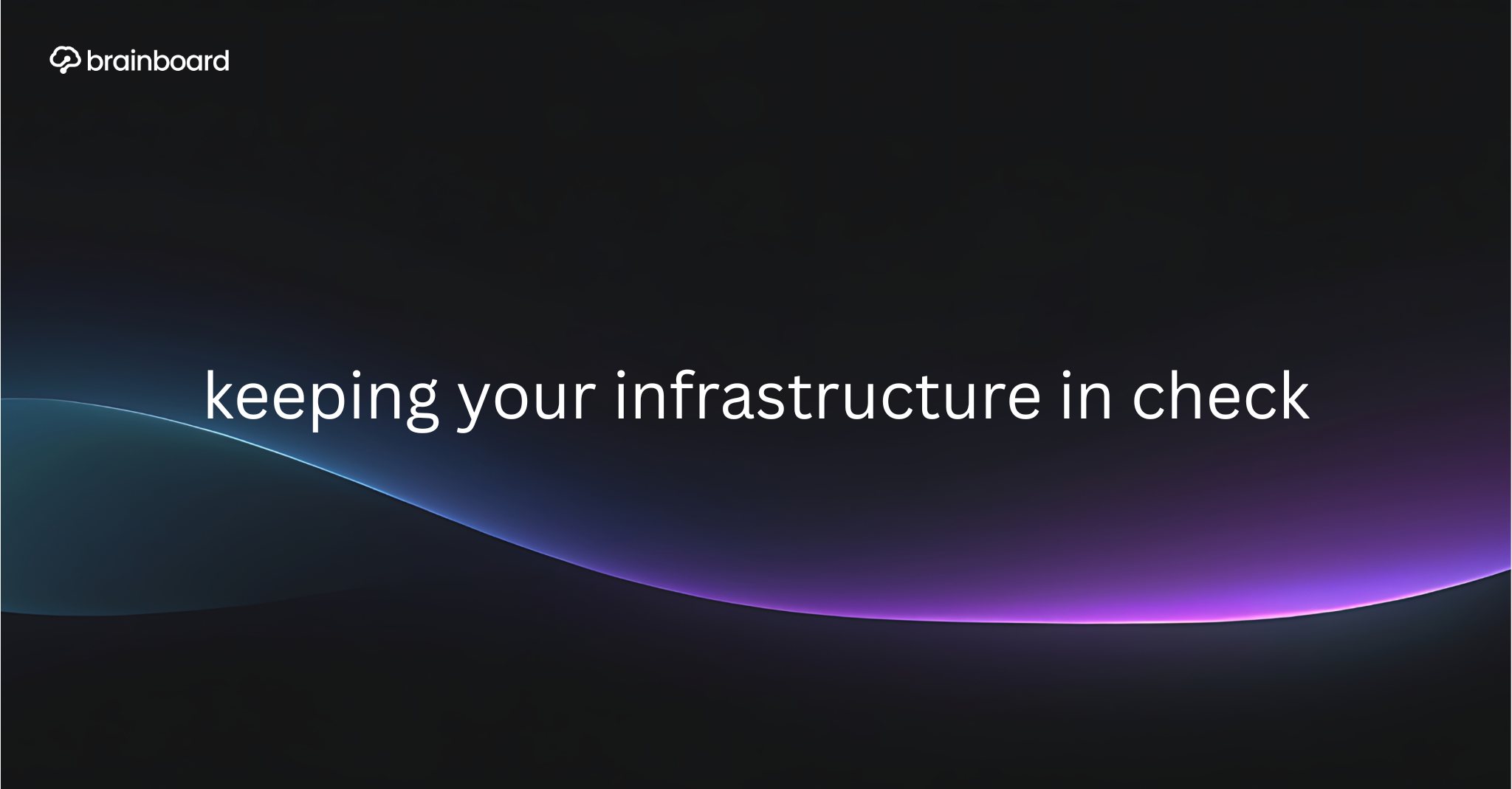Keep your infrastructure in check
Have you ever meticulously organized your closet, only to find it in complete chaos weeks later? That’s exactly what happens with infrastructure drift – except instead of misplaced socks, you’re dealing with security vulnerabilities, compliance issues, and unexpected outages. If you’re managing cloud infrastructure, drift isn’t just an annoyance; it’s a ticking time bomb that can derail your entire operation.
Why should you care?
Infrastructure drift occurs when your actual infrastructure configuration diverges from its defined state. Think of it as the gap between what you planned and what actually exists in your environment. It’s like following a recipe to bake a cake, but someone keeps sneaking into your kitchen and adding random ingredients when you’re not looking.
This phenomenon happens more often than you’d think. Maybe a developer makes a quick manual fix during an incident and forgets to update the code. Perhaps someone tweaks a security group rule directly in the AWS console to troubleshoot an issue. These small changes accumulate over time, creating a Frankenstein’s monster of configurations that nobody fully understands.
The consequences? They range from minor headaches to catastrophic failures. You might face security breaches because someone accidentally opened a port, compliance violations that result in hefty fines, or mysterious production issues that take days to debug. I’ve seen teams spend entire weekends trying to figure out why their staging environment works perfectly while production keeps failing – all because of untracked configuration changes.
Setting up your drift detection foundation
The first step in combating drift is establishing a solid foundation for detection. You need to know what “normal” looks like before you can spot deviations. Start by adopting Infrastructure as Code if you haven’t already – tools like Terraform, CloudFormation, or Pulumi give you a single source of truth for your infrastructure state.
But here’s where many teams stumble: they write IaC and then forget about it. Your infrastructure code needs to be the authoritative source, not just documentation. This means enforcing a strict policy: all changes must go through code. No exceptions. Yes, even during emergencies (though you might need a break-glass procedure for true disasters).
Version control becomes your best friend in this journey. Every infrastructure change should leave a trail – who changed what, when, and why. Git isn’t just for application code; it’s equally crucial for infrastructure definitions. Create meaningful commit messages that explain the business context, not just the technical changes. Future you will thank present you when troubleshooting issues six months down the line.
Implementing continuous drift detection
Now comes the exciting part – actually detecting drift before it causes problems. The key word here is “continuous.” Checking for drift once a month is like checking your smoke detector batteries once a year – by the time you discover the problem, your house might already be on fire.
Set up automated scans that run frequently – daily at minimum, hourly if your infrastructure changes often. There are few IaC tools that offer built-in drift detection capabilities. Terraform has terraform plan, CloudFormation provides drift detection APIs, and specialized tools like Brainboard offer enhanced drift detection features with remediation. The goal is to catch deviations within hours, not weeks.
But automation without notification is useless. Configure alerts that actually get attention. Slack messages for minor drift, PagerDuty alerts for critical deviations – calibrate your alerting strategy based on severity. Nobody should be woken up at 3 AM because someone added a tag, but everyone should know immediately if security groups change unexpectedly.
Create a drift detection dashboard that gives you a bird’s-eye view of your infrastructure health. Visual representations help spot patterns – maybe drift always increases after deployments, or certain teams consistently bypass the IaC process. These insights guide your improvement efforts and help prevent future drift.
Remediation strategies that actually work
Detecting drift is only half the battle – you need effective remediation strategies to close the loop. The most straightforward approach is automatic remediation: detect drift and immediately revert to the defined state. It’s clean, simple, and keeps your infrastructure consistent.
However, automatic remediation can be dangerous if not implemented carefully. What if the drift was intentional? What if reverting breaks production? This is where the concept of “reconciliation windows” comes in handy. Instead of immediately reverting changes, collect drift events over a period and review them before taking action.
Consider implementing a tiered remediation approach. Low-risk drift (like tag changes) can be auto-remediated immediately. Medium-risk changes trigger a review process. High-risk drift (security groups, IAM policies) requires manual intervention and investigation. This balanced approach maintains security while avoiding unnecessary disruptions.
Documentation is crucial during remediation. When you fix drift, document why it occurred and how you prevented it from recurring. Was it a training issue? A missing process? A tool limitation? These post-mortems become invaluable learning resources that help your team evolve.
Building a drift-resistant culture
Technology alone won’t solve drift – you need to build a culture that values infrastructure consistency. Start with education. Many developers don’t realize the impact of manual changes or don’t know how to properly use IaC tools. Regular training sessions and documentation can bridge this knowledge gap.
Make the right thing the easy thing. If developers resort to manual changes because the IaC process is too slow or complex, you’ve got a process problem, not a people problem. Streamline your IaC workflows, provide templates and modules for common patterns, and ensure your CI/CD pipeline is fast and reliable.
Implement the principle of least privilege rigorously. Not everyone needs console access to production. Use temporary elevated permissions for debugging, with automatic revocation after a set period. This isn’t about trust – it’s about reducing the attack surface for both security threats and accidental changes.
Celebrate wins and learn from failures without blame. When someone identifies and fixes drift, recognize their effort. When drift causes an incident, focus on improving processes rather than pointing fingers. A blameless culture encourages transparency, which is essential for maintaining infrastructure integrity.
Advanced drift detection techniques
As your infrastructure grows, basic drift detection might not suffice. You’ll need more sophisticated approaches to maintain control. Custom drift detection rules allow you to define what constitutes acceptable versus problematic drift. Maybe certain tag changes are okay, but any modification to encryption settings should raise red flags.
Predictive drift analysis takes things a step further. By analyzing historical patterns, you can predict when and where drift is likely to occur. Machine learning models can identify correlations between events (like deployments or team changes) and drift incidents, helping you proactively prevent issues.
Multi-cloud environments present unique challenges. Each provider has different drift detection capabilities and APIs. Tools like CloudQuery or Steampipe can help normalize data across providers, giving you a unified view of drift across your entire infrastructure landscape.
Don’t forget about application configuration drift either. While we often focus on infrastructure, application configurations can drift just as easily. Container images, environment variables, and application settings all need monitoring. Extending your drift detection to cover the full stack ensures comprehensive coverage.
Measuring and improving your drift detection maturity
You can’t improve what you don’t measure. Establish key metrics for your drift detection practice: mean time to detect (MTTD), mean time to remediate (MTTR), and drift frequency by resource type. These metrics reveal the effectiveness of your current approach and highlight areas for improvement.
Create a drift detection maturity model for your organization. Level 1 might be manual periodic checks, Level 2 introduces automated detection, Level 3 adds automatic remediation for low-risk drift, and Level 4 achieves predictive drift prevention. This roadmap helps communicate progress to stakeholders and sets clear improvement goals.
Regular audits keep your drift detection practice sharp. Quarterly reviews of drift incidents, remediation effectiveness, and process adherence ensure you’re not just detecting drift but actually preventing it. These audits often reveal systemic issues that individual incident reviews might miss.
Benchmark against industry standards and peer organizations. How does your drift rate compare? What techniques are others using successfully? Joining DevOps communities and attending conferences exposes you to new ideas and validates your approach.
Conclusion
Infrastructure drift is like entropy – it’s a natural force that constantly works against your efforts to maintain order. But with the right practices, tools, and culture, you can keep it under control. Remember, perfect drift prevention is impossible, but effective drift detection and remediation are absolutely achievable. Start small, iterate frequently, and gradually build a robust drift detection practice that keeps your infrastructure consistent, secure, and reliable. The journey might seem daunting, but every step forward reduces risk and improves your team’s confidence in the infrastructure they manage.
FAQs
How often should I run drift detection scans?
The frequency depends on your infrastructure’s rate of change and criticality. For production environments with frequent deployments, hourly scans are recommended. For more stable environments, daily scans might suffice. The key is finding a balance between timely detection and resource consumption – scanning too frequently can impact performance and costs.
What’s the difference between drift and configuration management?
Drift detection identifies when your infrastructure has deviated from its defined state, while configuration management maintains desired state across systems. Think of drift detection as the diagnostic tool that spots problems, and configuration management as the treatment that maintains health. They work together but serve different purposes in your infrastructure management strategy.
Should I automatically remediate all detected drift?
Absolutely not. Automatic remediation should be reserved for well-understood, low-risk drift. Some drift might be intentional (emergency fixes) or indicate a gap in your IaC definitions. Implement a tiered approach where only certain types of drift are auto-remediated, while others trigger alerts for manual review.
How do I handle drift in legacy systems that weren’t built with IaC?
Start by importing existing resources into your IaC tool – most modern tools support importing existing infrastructure. Document the current state thoroughly, then gradually refactor and standardize configurations. You might need to accept some level of drift in legacy systems while you modernize, but establish clear timelines for bringing everything under IaC management.
What are the cost implications of implementing drift detection?
While drift detection tools and processes require investment, they typically save money long-term by preventing incidents, reducing troubleshooting time, and optimizing resource usage. Cloud provider APIs for drift detection are usually free, though storing logs and running detection tools incurs costs. Consider drift detection as insurance – the cost of implementation is far less than the potential cost of undetected drift causing a major incident.

